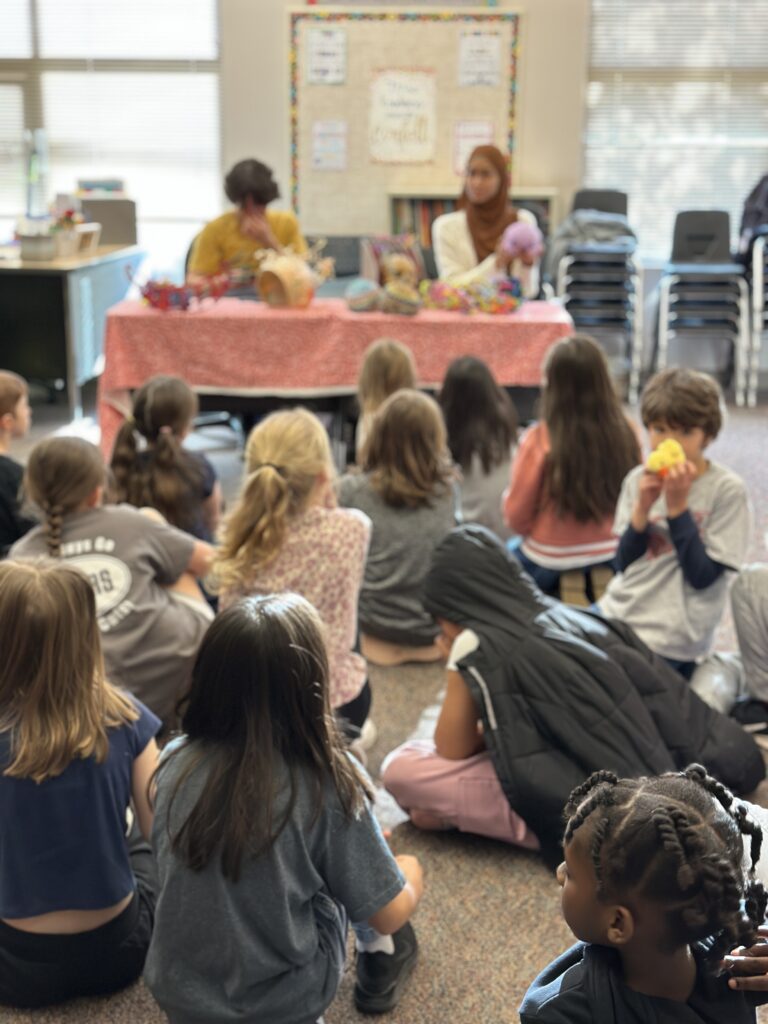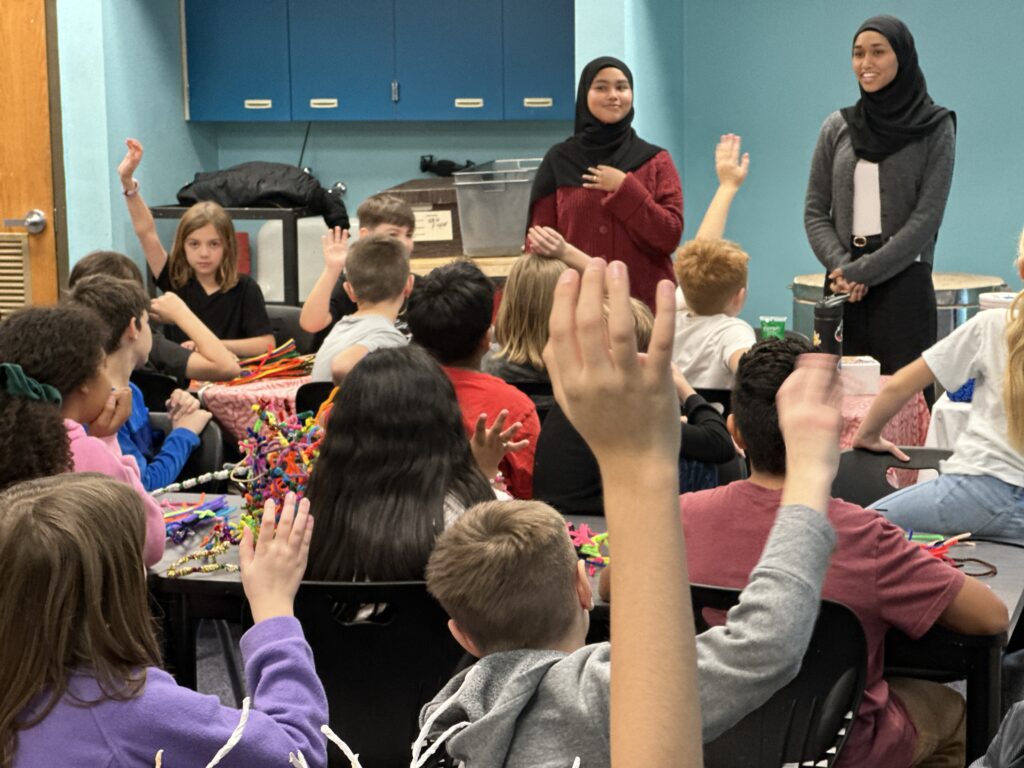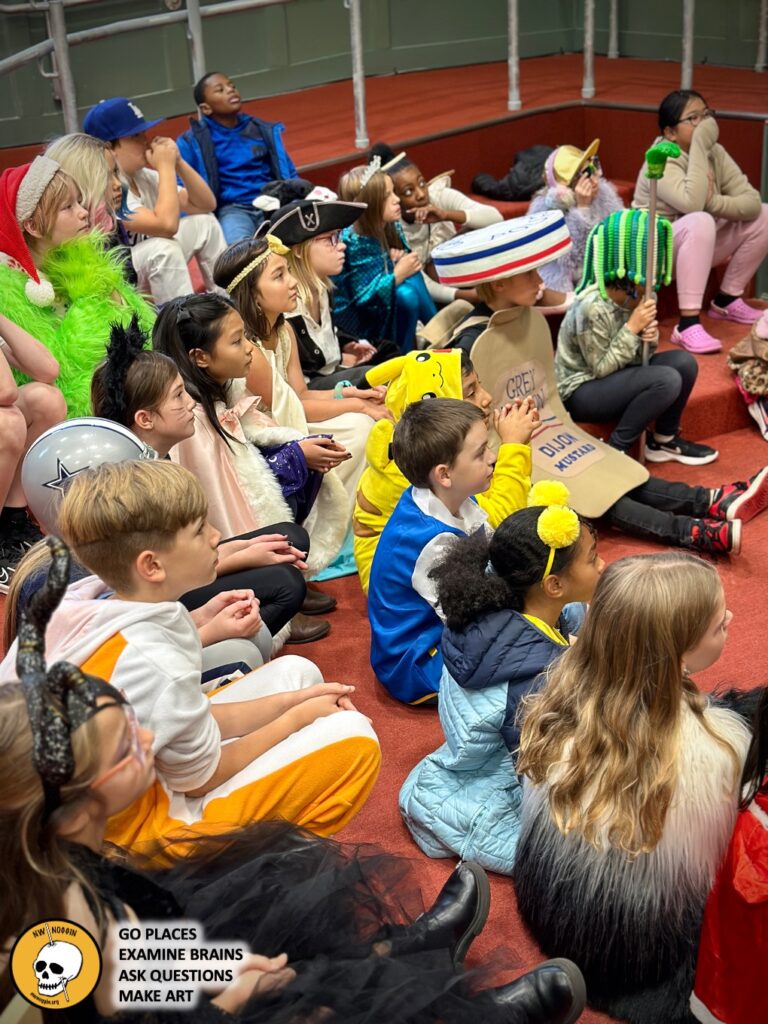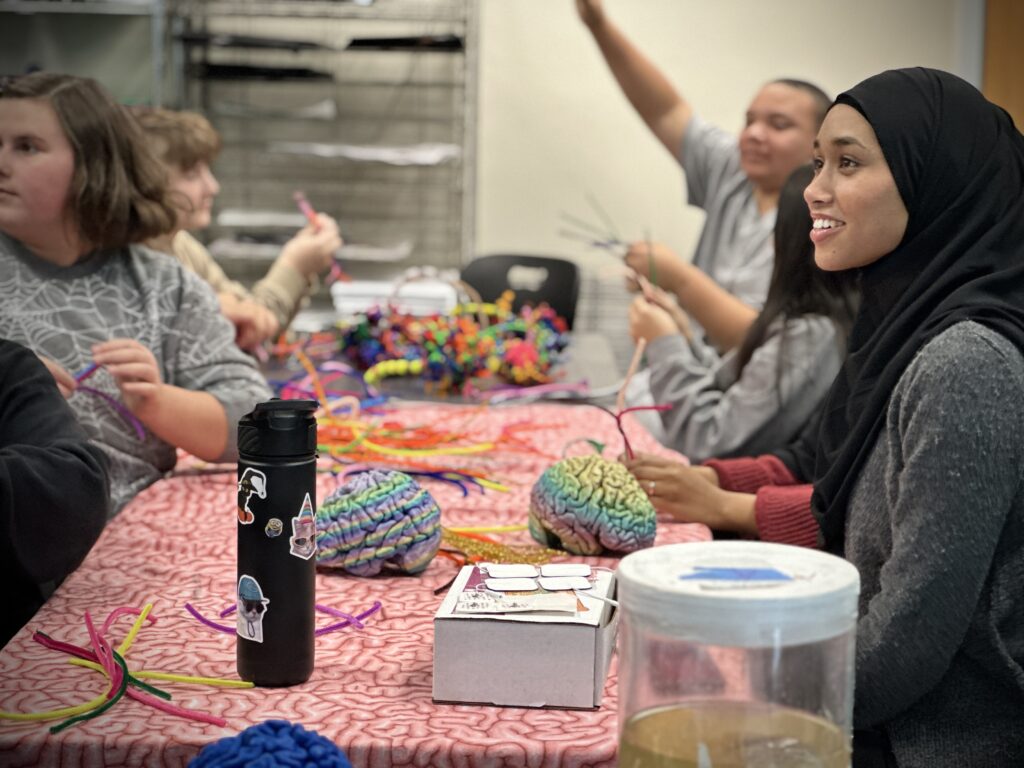Post by Maha Mukhtar, senior undergraduate at Portland State University pursuing a bachelors degree in Psychology with a minor in Interdisciplinary Neuroscience. This fall term she is a part of the Northwest Noggin outreach program.

This fall I’ve been visiting Portland area public classrooms, teaching kids about the brain and its functions. Each week, we visit a different school and teach multiple classes, and each class has its own set of unique and fun questions.

One of my favorite questions so far is: What is the purpose of our brain?

According to the National Institutes of Health (NIH), “the brain is the most complex part of the human body.” This three-pound organ is vital to everything — it controls our thoughts, perceptions, movements, and behavior. Every day, we rely on our brains for what we do, including our actions, our speech, and to drive our thinking and creativity.

LEARN MORE: Brain Basics: Know Your Brain
LEARN MORE: Who We Are – the National Institutes of Health

A student also asked me: Can we live without a brain?
The answer to this question is no, we unfortunately cannot live without a functioning brain. The brain controls everything from basic life functions like breathing and heartbeat to complex tasks like thinking, speaking, and moving. When someone is in a coma, they are not necessarily considered brain dead, as the brain may still function at some level, though these individuals no longer wake up.

LEARN MORE: Tres Escuelas en un Día!
LEARN MORE: Coma and consciousness: Paradigms (re)framed by neuroimaging
LEARN MORE: Brain function in coma, vegetative state, and related disorders
LEARN MORE: Brain death and disorders of consciousness
LEARN MORE: Brain death
The power of meditation
There were more cool questions, but I decided to explore the importance of meditation.
Not only does meditation help our bodies relax and regulate our emotions, but some neuroscience research finds that these practices can have longer term benefits, including improved focus, stress relief, reduced anxiety, boosted creativity, better memory, and even increased gray matter in the brain.

LEARN MORE: Meditation and Its Mental and Physical Health Benefits
LEARN MORE: Meditation and Mindfulness: Effectiveness and Safety
LEARN MORE: Mindfulness practice leads to increases in regional brain gray matter density
LEARN MORE: Systematic Review for the Medical Applications of Meditation
Meditation can calm your amygdala, and YOU
For example, Gaëlle Desbordes, a neuroscience researcher, conducted a study while at Harvard University that found that eight weeks of training in mindful attention meditation caused her subjects to show a decrease in the activity of a brain structure called the amygdala.

The amygdala is a region of your brain that helps you process emotions and respond quickly to often stressful situations. It can help you immediately determine whether something is harmful or entertaining. For example, when you see a snake, the amygdala produces a fear response, allowing you to react fast. It also helps you better remember emotional experiences, such as the thrill of winning a game or the anxiety of a close call, so you can respond more effectively in the future.
The amygdala provokes reactions based on previous experiences. Meditation ties into this because meditation can calm our amygdala response to stress, which makes it easier to manage our emotions and react more thoughtfully instead of impulsively, especially in high stress situations.
LEARN MORE: It’s Not Me, It’s My Amygdala!
LEARN MORE: Without my amygdala, would I get scared?
LEARN MORE: Understanding Emotions: Origins and Roles of the Amygdala

“Functional MRI (left) showing activation in the amygdala when participants were watching images with emotional content before learning meditation. After eight weeks of training in mindful attention meditation (right) note the amygdala is less activated after the meditation training.”
IMAGE SOURCE: When science meets mindfulness

This study suggests that regular mindfulness practice might help us become more emotionally resilient by reducing stress and enhancing calmness. A less active amygdala after meditation means that certain forms of mindfulness practice could modulate our brain’s response to emotional triggers (things that set us off), and lead to better regulation of our emotions.
LEARN MORE: Mindfulness & Resiliency (NIH)
LEARN MORE: Effects of Mindfulness on Psychological Health: A Review of Empirical Studies
LEARN MORE: Meditation and yoga practice are associated with smaller right amygdala volume
LEARN MORE: It’s Not Me, It’s My Amygdala!
Are kids under stress?
Many kids today are constantly on the go, juggling a full schedule that includes school, extracurricular activities, socializing, challenging circumstances and the demands of daily life. Stress can be positive. However, from rushing between classes to completing homework, some kids may have limited time to pause, sit down, close their eyes and simply relax.

This constant rush can lead to stress and fatigue, leaving less room for emotional or mental recovery. Recognizing this, I wanted to introduce a little meditation to help kids slow down, focus and reconnect with themselves. Some students were very curious!

Additional research finds that meditation can offer children a much-needed break in their hectic lives, allowing them to reset and recharge mentally and physically. By teaching them the importance of taking just a few minutes to center themselves, I hoped to offer an evidence-based tool they can use to better manage stress and cultivate mindfulness during busy days.
LEARN MORE: Role of meditation to improve children’s health: Time to look at other strategies
LEARN MORE: The Science of Early Life Toxic Stress for Pediatric Practice and Advocacy
LEARN MORE: Investigation of Stress Symptoms among Primary School Children
LEARN MORE: Definitions, theories, and measurement of stress in children
LEARN MORE: Is stress ever good?
Practicing meditation
While taking the Mind/Body Health (PHE 466) course at Portland State University with Dr. Claire Wheeler, I learned about devices called thermistors. Thermistors track your body temperature, and as you relax, your body temperature decreases, which the thermistor can measure. To use it, you tape the blue end of the thermistor to the inside of your middle finger with tape.

There are many forms of meditation, some of which activate the parasympathetic nervous system (the “rest and digest” system), leading to a drop in body temperature, while others activate the sympathetic nervous system (part of the “fight or flight” response), which can increase body temperature.
I chose to do a deep breathing style of meditation, which primarily activates the parasympathetic nervous system. This type of meditation encourages relaxation, helping to reduce stress and calm the body. This leads to a slight decrease in body temperature as you relax.
LEARN MORE: Measuring Temperature with Thermocouples, RTDs, and Thermistors
LEARN MORE: Thermographic evaluation of mindfulness meditation using dynamic IR imaging
LEARN MORE: Correlation of sympathetic and parasympathetic nervous system activity during rest and acute stress tasks
LEARN MORE: Sympathetic nerve activity and whole body heat stress in humans
LEARN MORE: Body temperature changes during the practice of g Tum-mo yoga
LEARN MORE: Neurocognitive and somatic components of temperature increases during g-tummo meditation: legend and reality
LEARN MORE: Body Temperature in Practitioners of a Yoga Breathing Technique Considered to be Heat Generating
LEARN MORE: Regulation of body temperature by the nervous system
LEARN MORE: The Temperature Dependence of Sleep
LEARN MORE: What Is Meditation? Proposing an Empirically Derived Classification System
Knowing that kids are very imaginative, I chose to use a script by Jon Kabat-Zinn.
Kabat-Zinn is well known for his mountain meditation, which invites you to imagine a mountain of your choosing. In this meditation, you focus on how the mountain remains still and steady through all the changes around it—the shifting weather, the changing seasons, and the passage of time. As you observe these changes, you come to realize that you are like the mountain: grounded, resilient, and unshaken by the ups and downs of life. This practice helps children develop a sense of inner calm and stability, teaching them how to stay centered even when external circumstances are constantly changing.
It’s a bonus that they get to imagine a mountain of their choosing; whether it’s rocky or bright pink it helps the kids get engaged more effectively.
LEARN MORE: Mountain Meditation
LEARN MORE: Guided Meditation: The Mountain
For these group of kids we tried a lying down breathing meditation.

Having a book on their stomach helped with taking deep breaths and feeling as their belly rose and fell with each inhale and exhale. The book served as a gentle reminder to slow down, focus, and connect with their breath. As they breathed in deeply, they could feel the book lift, and as they exhaled, they felt it gently lower, creating a calming rhythm. It was a very relaxing experience!
Meditation and forgetfulness
So…have you ever gone into a room and forgotten why you went there?

Have you ever started telling a story and then suddenly forgot what you were talking about? Have you ever meant to do something, but then got distracted and totally forgot about it? Have you ever gone to the kitchen then completely forgot what you needed?
When we experience moments like forgetting why we entered a room or misplacing items, several parts of the brain are involved, especially the prefrontal cortex and hippocampus.


If you forget why you went into a room or misplace your keys, it could be a sign that your prefrontal cortex and hippocampus are struggling to keep track of things. According to research, with regular meditation, you can strengthen both areas of the brain, improve your memory, and reduce the likelihood of these moments of forgetfulness.

So, the next time you’re distracted or forgetful, try a few minutes of mindfulness to refocus your mind and reconnect with your thoughts! You might even find those keys
LEARN MORE: Interplay of hippocampus and prefrontal cortex in memory
LEARN MORE: Functional Connectivity of Prefrontal Cortex in Various Meditation Techniques
What I learned
Through outreach I learned about the challenges children face in calming their minds, and I also explored the powerful potential of meditation for developing better emotional regulation and focus.
It was surprising to see how trying to calm down could sometimes increase stress, but it showed me how important it is to guide children through meditation in a patient, supportive way. I also realized that because children’s brains are still developing, they need more time and guidance to reach a meditative state compared to adults. Even short moments of mindfulness, though, can be incredibly beneficial.

One of the biggest lessons I learned was that many children, especially those in noisy or chaotic home environments, often have trouble finding quiet moments to relax.
Introducing short meditation sessions in schools could give these kids a much-needed mental break and help them to develop valuable skills for managing emotions and staying focused. Instead of phasing out nap time as kids get older, schools could replace it with brief, structured meditation. This would offer the same restorative benefits, while also teaching kids techniques they can use at home and in school.

In my own experience, I’ve found that even just five minutes of focused quiet time can improve my mood and concentration. Meditation has clear, lasting benefits for mental health, and bringing it into schools at an early age could help kids build resilience to stress, improve focus, and develop a deeper sense of calm.

As we continue to recognize the importance of mental health in education, meditation could play a key role in supporting students’ overall well-being, giving them tools to navigate school and life.



